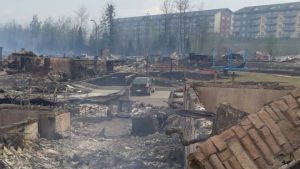The Insurance Bureau of Canada (IBC) has announced that an insured industry loss estimate from the May 2016 northern Alberta, Canada wildfires of C$3.58 billion (USD$2.8bn), makes it the costliest natural catastrophe event in Canada’s history.
 The Fort McMurray area of Alberta, Canada experienced the costliest natural disaster event in the country’s history earlier this year, as a wildfire tore through the region, causing widespread damage to land and infrastructure.
The Fort McMurray area of Alberta, Canada experienced the costliest natural disaster event in the country’s history earlier this year, as a wildfire tore through the region, causing widespread damage to land and infrastructure.
The estimate was published by the IBC but estimated by Catastrophe Indices and Quantification Inc. (CatIQ) and based on data reported by insurers.
In comparison to other parts of Canada, Alberta is susceptible to extreme weather events, highlighted by severe flooding in 2013 that incurred losses of C$1.7 billion (USD$1.31bn) and the initial IBC and Catastrophe Indices and Quantification, Inc. (CatIQ) insured loss estimate, of C$3.58 billion for the wildfires.
“This wildfire, and the damage is caused, is more alarming evidence that extreme weather events have increased in both frequency and severity in Canada. In recent times, wildfires and flooding have turned extreme and at times tragic,” said IBC President and Chief Executive Officer (CEO), Don Forgeron.
Despite not providing an overall, economic loss estimate, speaking during a media conference call, the IBC stressed that the majority of the overall loss of the wildfire will be borne by insurance policies, in some form or another, a contrast to the 2013 floods, said the IBC.
The IBC explained that policies weren’t available for all of the types of losses experienced in the floods, whereas wildfire insurance penetration is higher and in cases is included in home insurance in the region, owing to its vulnerability to wildfires.
CatIQ, a provider of analytical and meteorological information on Canadian natural and man-made catastrophes, reported that more than 27,000 property claims at an average of C$81,000 per claim form part of the estimate, which is grossed up to 100%.
The loss estimate, which includes business interruption losses, says CatIQ, also includes more than 12,000 auto claims that average C$15,000 a claim, and over 5,000 commercial insurance claims, at a cost of C$227,000 per claim.
It’s been reported previously that insurers in the region affected by the wildfire generally retain a low percentage of gross losses, suggesting that the lion share of the costs will be borne by reinsurers and providers of retrocession capacity.
In fact, analysts had said previously that reinsurers could shoulder as much as 70% of the overall loss from the event, underlining the important role insurance, reinsurance, and insurance linked-securities (ILS) capacity and skillsets play in providing risk transfer for key catastrophe peril regions.
With reinsurers expected to take a large slice of the loss, it’s likely some ILS players could be hit, although owing to its smaller size when compared to the overall reinsurance market this would likely only be limited.
But ILS does continue to play a greater role in the retrocession market; so increased losses there could result in some impact to private ILS placements, although this remains uncertain.
“As a country, we need to take a more disciplined and sustained approach to helping prepare Canadians for fires and floods. We must build a more resilient country to better protect those affected by the very real impacts of our changing climate.
“By taking action now, we can minimise costs to taxpayers and better equip homeowners for the risks and challenges that lie ahead,” said Forgeron.
Until the IBC provides and initial economic loss total and with the potential for its insured loss total to rise, although the IBC and CatIQ stressed that any fluctuation would likely be minimal, it’s not clear what percentage of the loss will be borne by the insurance and reinsurance industry.
But that fact that the IBC feels confident that insurance and reinsurance will pay the largest share of the costs, shows the important role risk transfer plays in creating a financially stable and resilient economy in the face of extreme, damaging weather events.
Of course we now also know that the wildfires have created losses in the ILS fund and reinsurance sidecar market as well.
PCS reported in June that its preliminary insured loss estimate for the event was C$4.6 billion (USD$3.52bn), and AIR Worldwide reported a range of between C$4.4 billion (USD$3.4bn) and C$9 billion (USD$6.9bn), so the IBC’s estimate is slightly lower, but at more than C$3.5 billion it’s the costliest single peril event during the second-quarter of 2016.
Also read:
– PCS puts Fort McMurray wildfire insured loss at C$4.6bn (US$3.52bn).
– Canada fires continue, set to be largest insured wildfire loss ever.
– Fort McMurray wildfire a US $3.4bn to $6.9bn insurance loss: AIR.
– Markel CATCo expects any Canadian wildfire loss to be minor.
– Reinsurance & retro to take significant share of Canada wildfire loss.
– Japan quakes, Canada wildfire to take nat cats over budget in Q2: JPM.
– Fort McMurray wildfire a “reinsurance event”, maybe ILS: Deutsche Bank.
– Fort McMurray wildfire could cost insurers up to C$9bn: BMO Capital Markets.
 View all of our Artemis Live video interviews and subscribe to our podcast.
View all of our Artemis Live video interviews and subscribe to our podcast.
All of our Artemis Live insurance-linked securities (ILS), catastrophe bonds and reinsurance video content and video interviews can be accessed online.
Our Artemis Live podcast can be subscribed to using the typical podcast services providers, including Apple, Google, Spotify and more.































